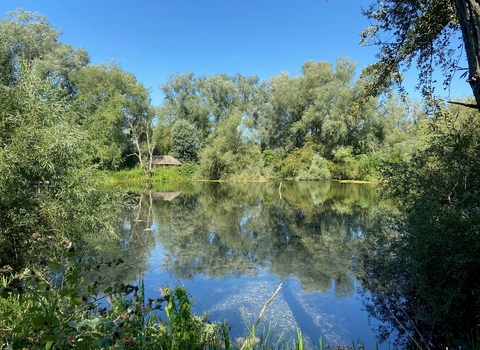The summer cut marks a dramatic change for hay meadows and woodland rides on nature reserves. Occurring in July for hay meadows, and typically in August for woodland rides, the cut appears at a glance to be extremely destructive. From an ocean of wildflowers to a cropped lawn, the cut removes large areas of habitat used by a range of wildlife including birds, mammals and many invertebrates. So why do it?
Species rich grasslands are, as the name suggests, fantastic habitat for a wide range of species, but are unfortunately in huge decline. Lowland meadows used to cover a quarter of the UK before the intensification of agriculture, but now that figure is about 3%. In Britain, floodplain meadow, a specific type of meadow, covers an area 300 times smaller than ancient woodland. In exceptional circumstances, floodplain meadow can support an incredible 40 species of plant per square metre. The high floral diversity in turn supports a high diversity of invertebrates and birds, with bats and other mammals also benefit from the management of meadows, creating a complex ecological system. Whilst floodplain meadows are particularly diverse, all grassland can be hugely beneficial for wildlife if managed sensitively. A loss or decline of an area of grassland will have a knock-on effect for countless species.
Eutrophication – or nutrient enrichment, is one of several enemies of the wildflower meadow. Perhaps surprisingly, more nutrients mean fewer species of flower, due to the ability of some bigger, coarser species to use those nutrients to bully out the more delicate species. Timing the cut right is important to maximise nutrient removal. Too soon and we don’t take enough nutrient, we lose the nectar source of the flowers and the plants won’t set seed. Too late and the nutrients return to the base of the plant. This has two downsides – if cutting for hay, the crop is less valuable as it’s not as sugar rich. Cutting late also insufficiently lowers nutrient levels – risking further nutrient enrichment over time. By taking the hay cut when the grass is at its richest, then grazing the subsequent regrowth (or ‘aftermath’) with cows and/or sheep, we remove lots of the nutrients and promote floral and faunal biodiversity. When cutting we often leave ‘refugia’ – small uncut areas for later flowers and invertebrates to have a fair go.
If we didn’t cut at all, a meadow would undergo a process called succession, transforming from flower and grass rich, to scrub rich, and eventually to woodland, meaning an eventual loss of the habitat completely (albeit with a new one appearing in its place). This can be seen across Nene Wetlands – areas that were once open grassland are slowly closing over with scrub and trees. Whilst scrub and woodland are beneficial to wildlife, the greater variety of well managed habitat types we have, the more biodiversity we have. So, to hold back the process of succession, we do various things. Cutting and grazing physically slows down scrub like hawthorn and bramble. Add to that a few Volunteer Officers with chainsaws, and a mighty Volunteer Work Party equipped with tools for scrub clearance, and our grasslands can thrive.
As mentioned earlier, one specific type of grassland - floodplain meadow – is particularly special. We’re lucky enough to have a patch of floodplain meadow at Nene Wetlands, at the far western end of Ditchford. Home to a rich variety of wildflowers, one notable example is great burnet – pictured above. Its Latin name, Sanguisorba officinalis, gives us clues to its long association with humans. The name translates as ‘The absorber of blood, from the monastery store’ – great burnet flowers were used as a way of stemming blood flow from wounds and nose bleeds. I like to picture folks in the Middle Ages walking around with great burnet flowers sticking out of their noses – wouldn’t that be a sight . . . Biologically it’s very interesting too: a member of the rose family, its extensive root system helps it survive tough conditions like extended periods of flooding, and a single plant can live for decades, if not centuries.
In some areas of Nene Wetlands, the topography or current state of enrichment or structure make a hay cut impossible. The undulating, wet field at the eastern end of Ditchford stays wet all year round, making it unsuitable for a hay cut. Here, cows graze off the vegetation, achieving a similar result as a hay cut. On the newly created Cettis Field near Higham Ferrers, the field is, at the moment, too scrubby and rough for a haycut. Our bull, Majestic, and his two companions are munching their way through, creating a variation in structure between the shorter areas they’ve eaten, and the taller areas they haven’t reached. This variation in structure promotes biodiversity, as different species will favour the slightly different conditions varied structure provides. Over time, with the right management, a greater variety of wildflowers will begin to win out at Cettis Field.
It's not just large areas of grassland that get cut – even smaller patches can be cut with a brushcutter and raked to remove the nutrient rich cuttings. At Nene Wetlands, the old railway path between Stanwick Lakes and Rushden Lakes provides extensive opportunity for pockets of wildflower rich grassland. Rome wasn’t built in a day of course, but in years to come, with the right management, the flowers will spread. It’s hard not to feel impatient though. When I see a patch of grassland swaying with wildflowers and rolling with butterflies under a midday sun, all the hard work is worth it. The cuckoo calls on nearby and the smell of sweet vernal grass drifts on the breeze. As conservationists, this is why we do what we do.
Why not grow your own meadow? If you have a patch of garden learn how to transform it into a mini meadow.


